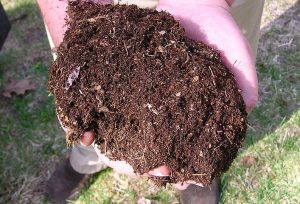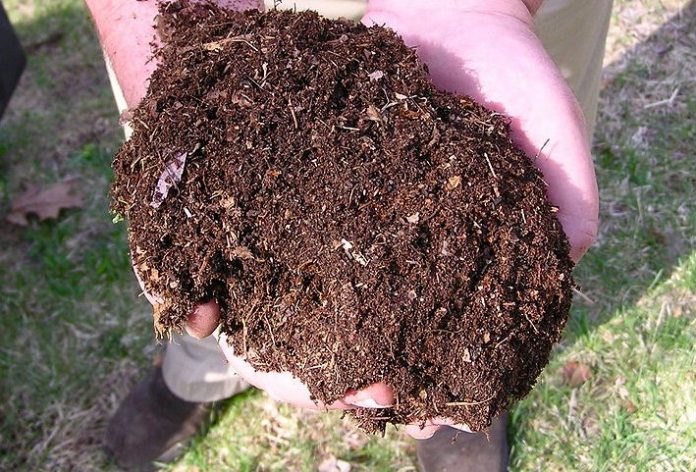
By Barbara Brown, Denton County Master Gardener Association
Many North Texas would-be gardeners are stuck with soil that severely challenges growing plants. Builders often add almost sterile topsoil to new homes, native soils may contain heavy clay that chokes off nutrition availability, and beneath the soil is alkaline caliche. One product helps mitigate all these challenges: lots of decomposed organic material, that is compost, integrated into your soil.
How to make compost
The good news is that nature creates compost automatically. Materials grown in the earth will eventually become compost. However, this natural process takes a long time—one to two years. Implementing a home composting system can speed up the decomposition process. Depending on the amount of raw materials you want to compost, you can choose to build a set of composting bins made of wood or cinder block, create a wire mesh enclosure to hold yard and food waste or invest in a manufactured composting bin or tumbler.
The best area for establishing a composting site is on bare ground so that composting organisms have contact with both soil and atmosphere. The pile should not be placed in direct sunlight that can be hostile to micro-organisms. Too much rain or standing water makes the compost pile too wet and causes it to become anaerobic. Choose a convenient location to allow easy access for turning and moistening.
A regularly maintained pile with a proper mixture of ingredients and moisture will successfully decompose organic materials. Composting happens more quickly if the pile is turned once or twice a week usually with a pitchfork. A pile should be moist but not sopping wet―think of a damp sponge that when squeezed releases just a few drops.
Under proper conditions, a composting pile will heat to a temperature of 70° to 100° as energy is released by bacteria breaking down raw materials. For more rapid decomposition, killing weed-seeds and bacteria, a pile requires a hot temperature—about 140° Fahrenheit. To achieve a high temperature, a pile should be fairly large, the ingredients added all at once, and the pile turned frequently.
What to put into your composting system?
Adding the right ingredient mix is the secret to making a compost pile work for you. Composting professionals talk about green and brown ingredients. “Greens” provide nitrogen while “browns add carbon. A simplified recipe is equal proportions by weight or 2/3 brown to 1/3 green by volume. Do NOT put meat, fats, dairy products, diseased plants or pet feces into your pile. Manure from cows and horses may be added as long as the animals have not fed hay treated with persistent herbicides (see more “Herbicide Carryover in Hay, Manure, Compost, and Grass Clippings” North Carolina Cooperative Extension Service, https://lee.ces.ncsu.edu/2016/03/herbicide-carryover-in-hay-manure-compost-and-grass-clippings/).
If greater precision is desired, online software will help assess the carbon to nitrogen ratio (C:N) for each ingredient type and amount being added. Quantities can then be adjusted to reach the desired ratio of 30 (carbon) to 1 (nitrogen) or 30:1. Cornell University offers a “Compost C:N calculator” http://compost.css.cornell.edu/download.html to help.
Examples of green ingredients:
- Fruit and veggie scraps
- Egg shells
- Tea bags, tea leaves
- Fresh green grass clippings and plant trimmings (grown without pesticides or weed killers)
- Garden refuse
- Green grass clippings
- Coffee grounds
Examples of brown ingredients:
- Chopped dry leaves, dried grass clippings
- Wood shavings or sawdust
- Straw
- Nuts and shells
- Untreated coffee paper filters
- Pinecones, pine needles—chopped
- Shredded newspaper and other paper products
- Twigs
- Peanut shells
When is compost ready to use?
The final stage of composting is called curing the pile. During this time, the pile cools down to ambient temperature and does not require turning or added moisture. The size of the pile should be one-half to one-third of its original size. This may take a couple months or the pile can be left unattended for several months before mixing into your garden soil. You will not be able to recognize most of the original materials in your finished pile and what remains should be dark and crumbly. The smell should be slightly sweet. You may choose to screen out of the compost the stubborn ingredients like egg shells, corn cobs and wood chips that did not fully decompose, but that is not essential. When the compost is ready to use, mix it into the soil about 6 inches deep to provide nutrition for plant roots.
Troubleshooting your composting system
The City of Lewisville Environmental Programs Office offers the following guide to ensure that your compost pile is working right:
- A bad odor means the pile is not getting enough air; turn the pile with a pitchfork.
- The center of the pile is dry; add moisture and turn the pile.
- Decomposition is not happening although the pile smells fine; add more nitrogen ingredients.
- The pile is damp only in the middle; add more material and moisten outside.
Resources:
EarthKind Composting Fundamentals―Raw material quantity and composition (https://aggie-horticulture.tamu.edu/earthkind/landscape/dont-bag-it/chapter-2-composting-fundamentals/)
EarthKind Composting Structures (https://aggie-horticulture.tamu.edu/earthkind/landscape/dont-bag-it/chapter-3-composting-structures/)










.jpg)



